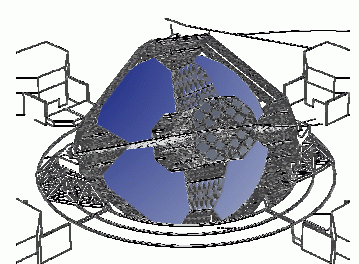 Now
that's what I call a large central element...the 100 m OWL.
Now
that's what I call a large central element...the 100 m OWL.
Angular resolution is a key to advance. The resolution of ALMA will be 10 mas at its highest, while achieving sensitivity to thermal (50 K) emission. Its field of view however, is somewhat limited, 3-4" at 350 microns. Larger fields of view will be assembled in mosaics. A diffraction limited 30m telescope should achieve similar resolution in the near infrared to what ALMA achieves in the submillimeter, with larger fields of view.
An AO-corrected field size would be (?) 3-4 arc minutes, similar to the cameras envisioned for NGST, and would allow for eventual multi-plexed spectroscopy and complementary imaging of NGST-like fields.
What is the case for the thermal IR (3-20 microns) where GSMT will not be competitive with NGST in terms of sensitivity but where the 4 times higher spatial resolution will allow large gains. The same dust which obscures objects in the ultraviolet and visible radiates brightly in the ALMA bands. GSMT could provide information on the short wavelength region of the spectral energy distribution of dusty objects. This provides a good measure of the bolometric luminosity of these objects.
What fraction is being missed in the optical/UV surveys which is re-radiated in the FIR/submm bands to be imaged by ALMA?
ALMA will detect and study the first luminous objects in the Universe-the
very objects which reionized it, ending the Dark Ages. Are these available
to GSMT?
Is there a case for the detection of earth-like planets around stars in nearby star forming regions, using GSMT in the thermal-IR (where the contrast between planets and host stars is minimized). ALMA can detect Uranus at nearby distances, and forming giant planets in nearby star forming regions. What is the synergy of ALMA spectroscopy with high resolution thermal-IR spectroscopy.
What is the science involving the chemistry of circumstellar disks using
thermal-IR spectroscopy? Most likely it will involve the solid components
emitting in the thermal IR in vibrational transitions of various molecules;
ALMA will provide details on scores of molecules in the same regions.
Will the sensitivity will be adequate for obtaining observations at
the thermal IR diffraction limit of GSMT (both imaging and moderate-resolution
spectroscopy) at the distances of important nearby star formation regions
(as a function of telescope emissivity). ALMA will image disks about stars
in these regions in the continuum as well as in various molecular lines.
Are forming protoplanets atmospheres dusty-is there a synergy between ALMA
and GSMT in spectroscopy of these objects?
How many stars will come into reach at the diffraction limit of a 30m
telescope? ALMA will detect thousands of stars, and image many of them
in reasonably short intervals.
What is the utility of thermal IR observations for studying nearby AGN.
ALMA will image the gas morphology and dynamics of the inner parts of AGN,
near the central black hole. GSMT will probe the atomic gas with perhaps
dynamic range limited by the central object brightness; ALMA the molecular
gas without dynamic range limitations and unobscured by dust.
ALMA will be able to measure gas content and kinematics out to z=3 or
more for Milky Way type galaxies. Can GSMT detect the stars-O stars, HII
regions, out to that distance? It would be important to connect the gas
with the stars forming from it.
In the solar system, ALMA will provide 'weather' observations of planets for spacecraft, measuring winds and temperatures on subcontinental scales. It can follow comets close to the Sun, where they are most active but lost to optical observations.